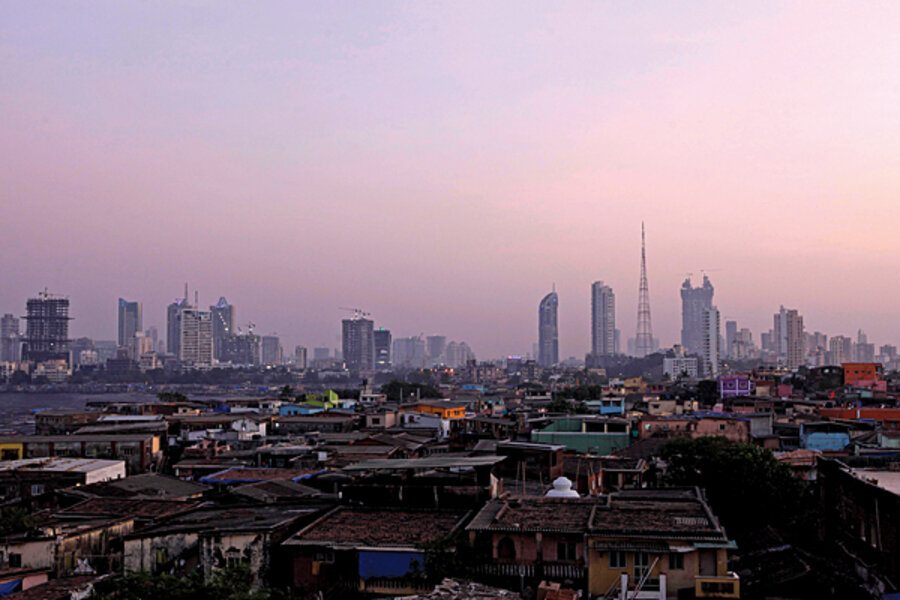India's economy loses its luster
Loading...
| New DeLhi
India's rise looks to be on the skids for now.
President Obama came to India in November 2010 hoping to hitch America's recovery to the Asian nation's inexpensive labor and emerging middle-class con-sumers. Indians talked of a future when millions of their own would be lifted out of deep poverty.
What a difference a year makes. It's not just that India's economic growth has skidded to a halt. A series of key government reforms have stalled while an anticorruption campaign has created uncertainty about what tainted money lies beneath balance sheets. Investors are fleeing.
"Foreign investors are as nervous as we have ever seen them about India's global investment environment," says Nick Paulson-Ellis, India head for Espirito Santos Securities. "Many United States investors have pulled out entirely."
In 2011, foreign institutional investment totaled just a fifth of what it was in 2010, and India's benchmark stock index, the SENSEX, lost a quarter of its value.
If a crisis of confidence in India delays or derails the country's climb, the US faces a setback in its efforts to find a new China – one more interested in buying US goods and sharing democratic values. And for Indians, the price of under-performance means another generation – this time nearly one-sixth of humanity – burdened by widespread poverty.
"The two-point swing in growth this year from the projected 8 to 9 percent to 7 percent is a very big deal," says Gurcharan Das, an Indian economist and author. "Each percentage point is about 10 million new jobs."
While the US would be thankful to be staring at 6.9 percent growth, some experts say India needs at least 9 percent growth to keep pace with its population.
A number of factors, including a paralyzed government, corruption, high inflation, and a depreciating rupee are behind the slowdown.
The chairman of Goldman Sachs Asset Management, Jim O'Neill, who coined the acronym BRIC (Brazil, Russia, India, and China) to describe the four biggest developing economies, is also raising the alarm. At a 2012 investment outlook summit in December, he said that the BRIC economies are performing at a higher level than he had predicted in 2001, but that India is the most disappointing performer and suffers from a severe lack of leadership.
"India is as bad as Russia on governance and corruption and, in terms of technology, Russia is in fact much higher than India," said Mr. O'Neill.
However, economist Mr. Das, who forecast India's boom in the 1990s, suggests this is just a bump in the road.
"When you look at the big picture, this is not a big deal. India is still one of the fastest-growing economies," says Das. He says there is a "real paralysis of government," but that the fundamentals of the country are strong, and India's economy is less dependent on its government than other countries are.
But Rajiv Kumar, secretary-general of the Federation of Indian Chambers of Commerce and Industry, disagrees.
"To me, this whole thing about India being able to grow despite the government is ridiculous," says Mr. Kumar. "There was a phase [when] that could have been true, but that time has passed. Indian industry is already finding it impossible to compete in the internal and external markets."
Government reform is key
Kumar and Das both agree that for the country to move forward, major reforms need to happen. Reforms like the Land Acquisition Act, which would allow the government to acquire private land for public use, have been stalled for years.
Sumit Ganguly, a South Asia expert at Indiana University in Bloomington, says the delayed reforms impede India's growth and discourage investors.
"India can't afford to stop billion-dollar investments," says Professor Ganguly, referring to the decision last year to block a major international company from developing private land in a remote area. "There is a need for better jobs. A whole generation of people can't support themselves on fishing and farming."
Ganguly says that opening India's doors to foreign investment in multibrand retailers like Wal-Mart will also fuel growth. Last year, the government agreed to let in such retailers but backtracked amid popular pressure. A retail reform passed in early January is paving the way for "single-brand retail" stores like IKEA and Starbucks to come here; big-box stores are still waiting.
550 million under age 35
Though job opportunities may have dimmed for millions, many youths still anticipate a brighter future.
"Though you can never really be secure about a job until you have one, I'm not too worried about getting a good position when I graduate," says Ektaa Jain, a student at Jawaharlal Nehru University.
For entrepreneurs like Satyanarayan Pitroda, it's the 550 million Indians younger than 35 who will be India's strength. Taking into account India's history of innovation, he says, it's inevitable that the country's productivity will pick up and the boom will continue. The SENSEX has started to rebound.
"I'm not looking at India from a one- or two-year scenario," says Mr. Pitroda, who is an innovation adviser to the prime minister. "I'm looking at where India is going in the next 20 years."







